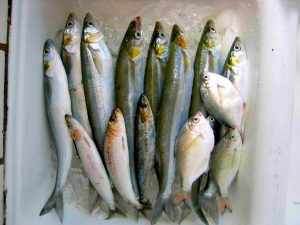
Jacksmelt and perch
Jacksmelt are a mid-water species, often 4-6 feet below the surface, so anglers using Sabiki-type bait rigs will employ a variety of devices to keep their baits at near the surface. Some use balloons (a bad idea for the environment), some use big bobbers, some use a piece of Styrofoam and all will work. Generally the big smelt (to around 14-15 inches) prefer a piece of pile worm for bait although at times they will hit nothing but pieces of shrimp, strips of squid, or pieces of anchovy/mackerel. They can be finicky at times; at other times it is wide open anything goes action.
Some years may also see Pacific mackerel and/or Spanish mackerel (mackerel jack). If they are present the same rigs and same baits will work as for jacksmelt. One thing to note is that a Sabiki rig filled with a whirling dervish mix of four-six mackerel often means a complete mess and a loss of the tangled leader. It’s one reason I stick to my two-hook high/low rig, which also seems more sporting. Plus, why do you need to catch a half dozen mackerel at a time? Are you really going to eat that bucket full of fish?
Pacific sardines are a fish that showed increasing numbers in the ‘90s and diminishing numbers after about 2008. However, they seem to be increasing again and if/when they show at the pier they can be caught in huge numbers, 4-6 at a time, with unbaited bait rigs. Simply cast out the Sabiki or Lucky Lura utilizing a torpedo sinker heavy enough to cast through the wind, let the rig sink midway to the bottom and begin a retrieve. Some times a fast retrieve is needed, sometimes a herky-jerky retrieve is better (it seems to vary) but once you get the technique you should catch fish. They are good eating and they make great bait.
If the sardines show up during the striper season (spring to fall), knowledgeable anglers will put a live sardine on a trolley line rig near the surfline. Oftentimes a striper will be the result.
Everything said about the sardine can be applied to Pacific herring although the herring will generally make a wintertime visit if they decide to make a stop at Pacifica on their way to San Francisco Bay. As such they aren’t utilized for live bait unless an angler is really hopeful. But, they still are good eating and good frozen bait.
Northern anchovy also make great bait and sometimes seem to cover the pier’s waters. When present, bait rigs can be employed but use a smaller-size hook than that used for the larger fish. Typically a steady retrieve is all that is needed to hook the small bait fish. Pizza anyone?
Do be cautious. One trip saw me jigging with a Lucky Lura leader for some live bait (to use on my heavier salmon rig). Unfortunately, the water was thick with smolts (baby salmon) about the size of herring. After hooking and releasing about a dozen of the small fish, I decided to call it quits with the leader. Unfortunately not all the anglers that day looked at things the same way and too many of the small fish were kept and killed. These small, illegal fish need to be left alone by anglers. Enough of these fish will be eaten by other predators before reaching adult size so don’t complicate their lives any more than necessary.
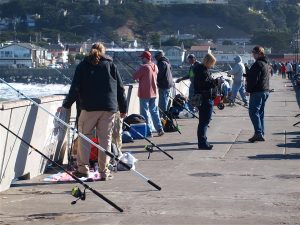
Flatfish—Four main flatfish are caught and each require different rigging.
Two sanddab species show at the pier, speckled sanddab and Pacific sanddab. The speckled are a small species too small to keep as food and never, at least to my satisfaction, proven to be decent bait. The speckled sanddab are an incidental fish caught year round and showing up unexpectedly whenever a small hook baited with food is left on the ocean floor.
Pacific sanddab are larger (although not big) and provide good table fare if enough are caught — and that’s rarely a problem. The fish are a schooling species and when present are caught in large numbers. Use a two-hook high/low with size 6 or 4 hooks and you’ll probably get two fish. Use a six-hook bait rig and you might get six fish.
Cast out the line, let it sit on the bottom until you start to feel the nibblings of the ‘dabs and then begin a slow retrieve. Whatever hooks are still empty may be grabbed by a fish. Baits vary but I’ve had the best results using pile worms. But when they are hungry they will hit almost anything—pieces of anchovy, small pieces of shrimp, or small strips of squid.
Unfortunately they do not make a showing ever year and when they do show they usually only make a short December-January appearance. In addition, my records show that almost all of my sanddab catch at the pier was made early in the morning, right at daybreak and all the fish were caught out at the end. Anglers fishing mid-pier caught few if any sanddab and those coming later in the day never saw a single sanddab.
Sand sole are an interesting mid-sized flatfish that is both attractive and good eating. Luckily for Pacifica anglers, the pier is probably the best in the state for the sole. They are most commonly caught in the mid-pier area and can be encountered in almost any month of the year (although summertime, especially June and July, is the peak season for the fish). The largest I have caught at the pier was a 19 3/4-inch sand sole caught during my first visit to the pier in September 1975.
As to rigging and bait, I’ve caught them on both high/low rigging’s and on a sliding live bait leader. Best baits include pile worms, cut bait—anchovy, sardine or even squid, and shrimp. Unfortunately many anglers do not recognize sand sole for what they are, they think they are halibut, and release the fish as under-sized. Know your fish!
Fishing the same area may also attract another mid-sized flatfish — starry flounder. They’ve been reported to 12 pounds at the pier although the largest I’ve caught was a July ’78 fish measuring 17 3/4-inches.
Best luck for these is with (a) one of the traditional Bay Area sliding live bait leaders (plastic that attaches to a sinker while the line goes through the plastic) or (b) a Carolina-type live bait leader (line through a hollow egg sinker before attachment to a swivel and then a 2-3 foot leader. attached to. Live bait, a small smelt or small perch works well as does pile worm and cut bait—anchovy, sardine, squid, etc.
California halibut are the prize flatfish at the pier. They’re primarily caught from May until September and fish to 32 pounds have been landed. They’re found mid-pier out to the end (although it’s hard to fish for them at the end if a salmon run is on).
Almost all halibut are caught on live bait — anchovies, small smelt, small perch, or sardines, and some type of live bait leader is used. The plastic Bay Area variety works as well as the Carolina rigging although some people try the same sliding “trolley” leader used for salmon. Although artificial lures are one of the most efficient ways to land halibut in SoCal, and “trolling the pier” in the depressions between the pilings might produce fish, the sheer number of anglers, combined with the vicious tides and current sometimes found at the pier, make artificial lures an “iffy” proposition.
If fishing for the halibut make sure to use at least 20-pound test line and be sure to have a hoop net to bring the halibut up to the pier.
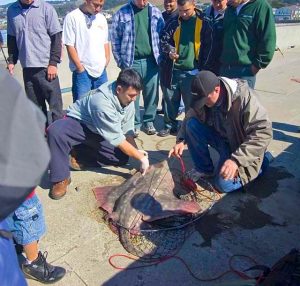
Big Skate — 1998
Sharks and rays—As mentioned, the pier is not noted for sharks or rays. Nevertheless some sharks are caught, mostly leopard sharks or brown smoothhounds. In addition, a few “shark anglers” still give thresher sharks a try if the pier isn’t too crowded.
Leopards and smoothhounds are common from almost the tideline to the end but most are hooked in the mid-pier area. They can be hooked on high/low rigs as well as Carolina-type rigs. If using a Carolina rig try baiting up with a small perch—walleyes, silvers and spotfins, or sardines (if they are running). For high/low rigging’s use cut bait—anchovies, sardines, mackerel or squid.
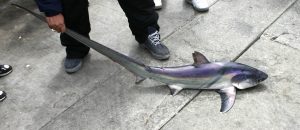
Thresher Shark
Thresher sharks are the favorite of anglers and threshers to 10-feet in length have been recorded (although much of that was the long tail). For those seeking out the large sharks the equipment is usually a fairly heavy 9-12 foot rod, a large reel equipped with 50-100 pound line, and a sliding live bait leader. A 5-7 ounce sinker is cast out as far as possible and then the sliding leader is snapped onto the line before sliding the leader down the line. The leader is fairly long with a float of some type (big bobber or Styrofoam) located mid-way down the leader to keep the rig near the surface. Another 6-8 feet of leader is under the float terminating in a large hook and lively bait. Treble hooks are favored by many anglers since threshers will often swat the bait with its tail before biting it bit some anglers simply use a large hook.
Striped Bass — Striped bass are one of the two prized fish at the pier and, unlike salmon, seem to be taken in fair to good numbers every year. It shouldn’t be surprising given the fame that local waters held for stripers for so many years.
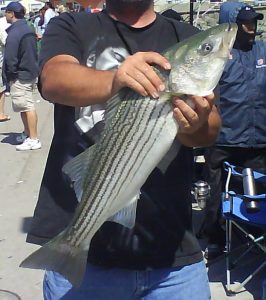
The bible on stripers says they leave the inland streams, move through the Delta, and pass through San Pablo and San Francisco into the Golden Gate and Pacific waters every spring. In the fall they reverse that trek. Thus the normal June to October striped bass season makes logical sense (even if many locals consider July 4 as the kickoff date for Mr. Linesides). When they start to be caught the season is on!
Most are caught on the inner third of the pier, often right in or next to the surf with both bait fishermen and those casting artificial lures welcome (if the pier isn’t too crowded).
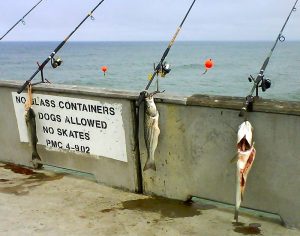
Stripers
Although techniques change over the years, a high/low leader baited with pile worm, ghost shrimp, or whole or cut bait—sardine, anchovy or small perch, is still often the best bait. An alternative is a live bait and usually today that means employing a Carolina-rig with whatever live bait can be procured—shinerperch, small surfperch, small smelt or, if they are running, a sardine (although a pile worm can also be used with the rig).
Use a hook size 2 to 4/0, heavier line (at least 20-pound test), and be sure to have a way to bring the fish up onto the pier since stripers to at least 43 pounds (maybe bigger) have been caught off the pier.
Another approach is to use an artificial lure, most likely a plug or spoon, fish an area away from other anglers (if you can find such a spot) and cast just outside or even into the surf line. During the low tide, check out the inshore area and look for depressions along the surf, these are the places to try first. Unfortunately, it is harder for a pier fisherman to use these lures than an angler fishing from the beach (although Mickey Jigs and Pencil Poppers tend to compensate for heavy wind conditions). If conditions permit (somewhat light winds), you can try lighter spoons and jigs. Krocodile spoons (chrome with a lime-green strip,) or Hopkins jigs, are the choice of many surfcasting “experts.”
Salmon — King salmon are, of course, what made the pier famous and at least a few are usually present most years. If they show up the season can run from June until October or November (although late June to late July is generally the peak time). Hundreds of bobbers/floats will dot the surface of the water when a “run” is on, ranging from the surf area to the end of the pier. The best spots, when you can get them, are at the far end, both the left corner, and the end area that runs to the right corner (an area affectionately known as “Little Manila” or “Manila Town” and populated by the regulars—“The Filipino Mafia.”
Most of the salmon are caught by the regulars using the famous Pacifica trolley rigs, modified sliding “trolley” leaders. A heavy saltwater rod and reel, spinning or conventional, equipped with 30-50 pound line is used. At the end of the line a 5-8 ounce spider or sputnik-type weight is attached, size depending upon the current. These weights have four spikes on one end that are set into position by pulling the line in a low position after the cast; if done correctly the spikes will be wedged into the sand. The trolley leader is then slid down the line via a strong snap swivel. The leader itself has a float (usually a large 3-4“ Styrofoam bobber set a couple of feet under the swivel to keep the leader near the top of the water. Some anglers will then attach a reflector (flasher) of some type to attract fish but they’re rarely needed. The leader extends another 10-20 feet or so under the bobber depending upon the tide and the depth at which the salmon are feeding. The leader terminates in a hook and bait. The hook should be a barbless circle hook, the legally required hook for salmon in California (although many ignore the rule). Typically the bait is a “popsicle’—a frozen anchovy that has been threaded onto the leader by the use of a bait thread needle.
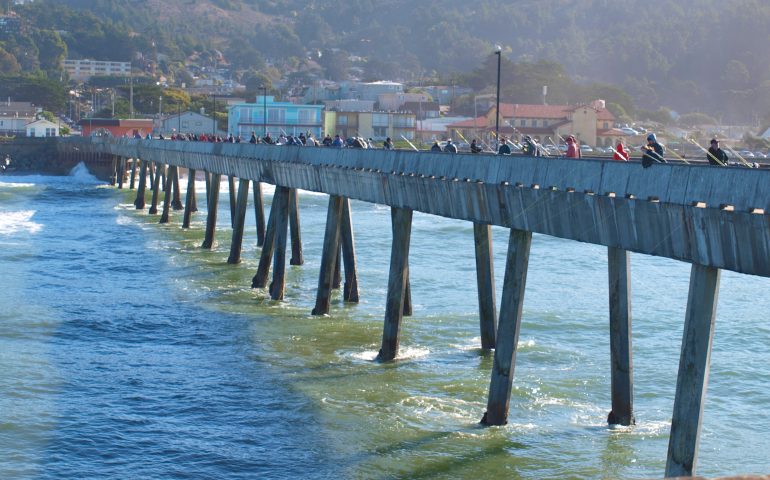
One of the best fishing pier. Got a lot salmon, stripers, perch on this pier. Go there early.
So is it safe to eat the kingfish?
In general, open-ocean areas like Pacifica have perfectly safe and delicious kingfish populations. We fished there in June and caught several large kingfish (among 9 species of fish and crabs caught) that were clean, healthy, and free of the commonly found small worms.
I enjoyed your description of fishing at Pacifica Pier and the pictures. Well done. Very interesting with lots of information.
great commentary on fishig the pier. thank you.
Would you know the length of rope needed for crabbing off of the Pacifica Pier, CA.?
jesse r king i had 100ft of rope last time i went and it was plenty.
Hi! I love this website.
A lot of people say squid on a Sabiki does not work on a sabiki, but
when I was fishing at oyster point peir I hooked an 18 – inch jacksmelt.
My girlfriend and I went to Pacifica Pier on April 3, 2021. We didn’t see a lot of people on the pier. We walked along the pier and stopped just short of the end before turning around and heading back. We did see a man bringing in his catch of the day through using a small boat he pulled up on the beach. We continued our walk just beyond the beginning of pier and eventually headed back to the car.
After the superficial damAge this past January The city closed the entire pier and was debating weather to close the pier permanently. They refused my calls to partially open it claiming it could collapse even though no expert said that.
And they refused to repair it. So I got the California Coastal Commission (CCC) involved around March 15 2021 who said the city can’t deprive the public of access without a permit from them. They immediately had the city partially open it and are now overseeing the city’s repairs which are moving very slowly because the city is crying poor even though the want to spend 12 million dollars on a new city hall.
Good to know that the CCC has jurisdiction over the piers
Thank you for your efforts on the pier.
The pier is in disrepair. The end is blocked off and is falling apart. Sad.. needs restoration!!
Started fishing here in 1985 I was 5 saw many things on that pier and in the water. A Great white shark swimming under the pier. Caught thresher sharks, hooked and lost blue sharks, caught salmon, and stripers, saw 40 pounder king salmon getting caught there. Old Cecil selling his undersized anchovies at international point. Watching mute Ron cast the 8 oz pyramid on international point father than anyone I’ve seen. Caught small shiners, pompano, smelt, king fish (croaker) jigged for sardines and anchovies, caught dungeness, red and rock crabs, countless bullheads piled up on the corners because nobody wanted them but great as striper bait in the carquinez! Halibut, I seen one giant sea bass caught. Seen many salmon stolen by sea lions while the og fisherman tried to hand line them in the pier when the crab net was too slow to be dropped to scoop up the fish. Pulled many bobbers and fish from the pickings during the 95 salmon run when nobody cared to retrieve there set ups. Many memories. Lots of bbgs, fights, and card playing (Pusoy) seeing bud drunk as hell but finding a way to still catch fish. Many familiar faces but never really knew names. Rudy and his son marcel. The ogs on that pier I thank my father Arnulfo Sarmiento for teaching me how to fish me and my brother Joshua. It’s sad that the pier doesn’t have the salmon fishermen anymore and now it’s just the crab snaring crowd but I don’t hate I know the salmon are there but nobody try’s because nobody knows how to fish the top and the bottom of that water for them anymore. It is the best fishing pier in California and maybe one of the best in The U.s.a
Paul, Thanks for the report. I spent many a day there back in the mid to late ’70s when I lived in the Bay Area. Later, after moving north, there were far less visits but it’s still a favorite pier to visit when I am in the area. Ken
For Paul Sarmiento… a bit of instruction on how to catch Salmon off the pier would be appreiated.
In a fairly suburban area like we live in….Pacifica still has a great getaway Beach feel to it.
As I slide into my 80’s, my wife and I still like to to walk Pacifica and I always learn something
every time I fish; even to walk the pier and ask “what’s running”.